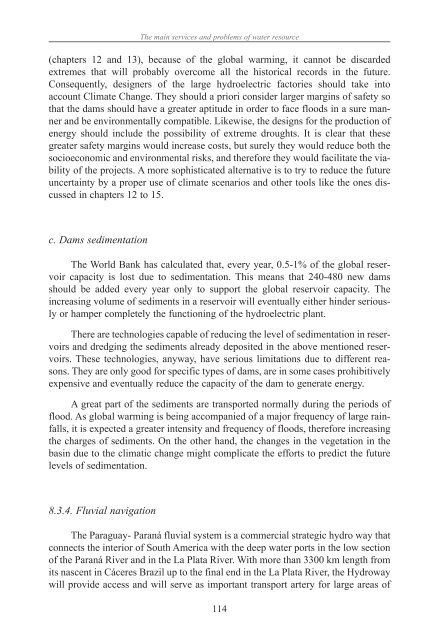chapter - Atmospheric and Oceanic Science
chapter - Atmospheric and Oceanic Science
chapter - Atmospheric and Oceanic Science
Create successful ePaper yourself
Turn your PDF publications into a flip-book with our unique Google optimized e-Paper software.
(<strong>chapter</strong>s 12 <strong>and</strong> 13), because of the global warming, it cannot be discarded<br />
extremes that will probably overcome all the historical records in the future.<br />
Consequently, designers of the large hydroelectric factories should take into<br />
account Climate Change. They should a priori consider larger margins of safety so<br />
that the dams should have a greater aptitude in order to face floods in a sure manner<br />
<strong>and</strong> be environmentally compatible. Likewise, the designs for the production of<br />
energy should include the possibility of extreme droughts. It is clear that these<br />
greater safety margins would increase costs, but surely they would reduce both the<br />
socioeconomic <strong>and</strong> environmental risks, <strong>and</strong> therefore they would facilitate the viability<br />
of the projects. A more sophisticated alternative is to try to reduce the future<br />
uncertainty by a proper use of climate scenarios <strong>and</strong> other tools like the ones discussed<br />
in <strong>chapter</strong>s 12 to 15.<br />
c. Dams sedimentation<br />
The World Bank has calculated that, every year, 0.5-1% of the global reservoir<br />
capacity is lost due to sedimentation. This means that 240-480 new dams<br />
should be added every year only to support the global reservoir capacity. The<br />
increasing volume of sediments in a reservoir will eventually either hinder seriously<br />
or hamper completely the functioning of the hydroelectric plant.<br />
There are technologies capable of reducing the level of sedimentation in reservoirs<br />
<strong>and</strong> dredging the sediments already deposited in the above mentioned reservoirs.<br />
These technologies, anyway, have serious limitations due to different reasons.<br />
They are only good for specific types of dams, are in some cases prohibitively<br />
expensive <strong>and</strong> eventually reduce the capacity of the dam to generate energy.<br />
A great part of the sediments are transported normally during the periods of<br />
flood. As global warming is being accompanied of a major frequency of large rainfalls,<br />
it is expected a greater intensity <strong>and</strong> frequency of floods, therefore increasing<br />
the charges of sediments. On the other h<strong>and</strong>, the changes in the vegetation in the<br />
basin due to the climatic change might complicate the efforts to predict the future<br />
levels of sedimentation.<br />
8.3.4. Fluvial navigation<br />
The main services <strong>and</strong> problems of water resource<br />
The Paraguay- Paraná fluvial system is a commercial strategic hydro way that<br />
connects the interior of South America with the deep water ports in the low section<br />
of the Paraná River <strong>and</strong> in the La Plata River. With more than 3300 km length from<br />
its nascent in Cáceres Brazil up to the final end in the La Plata River, the Hydroway<br />
will provide access <strong>and</strong> will serve as important transport artery for large areas of<br />
114






